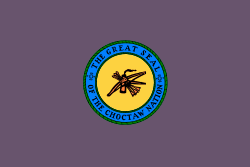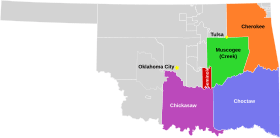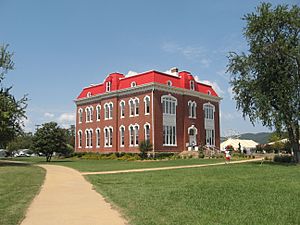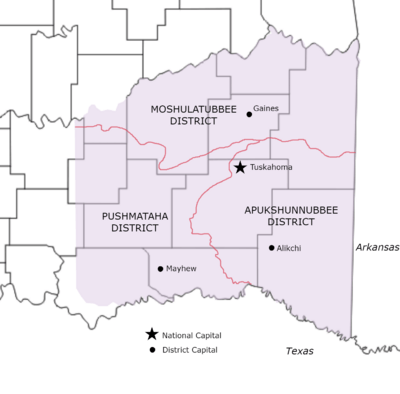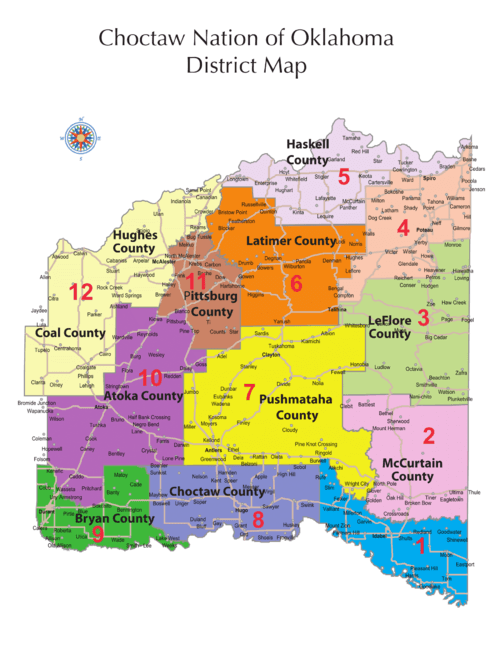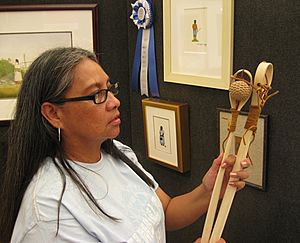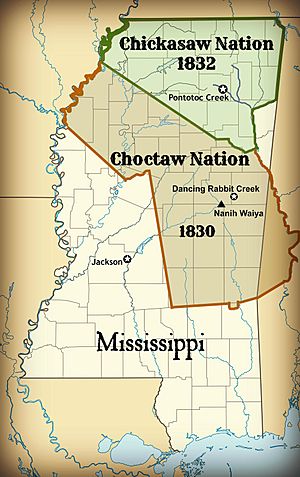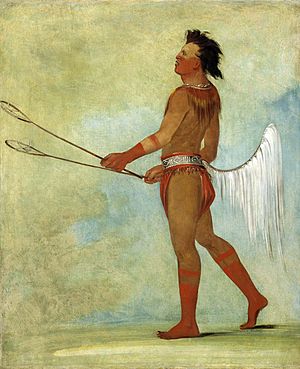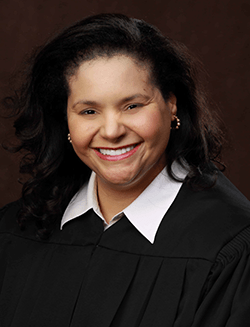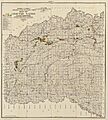Choctaw Nation of Oklahoma facts for kids
Quick facts for kids
Choctaw Nation
Chahta Okla (Choctaw)
|
|||
|---|---|---|---|
|
|||
| Anthem: ("Nahata Fichik Tohwikeli" and "Antvt bilia" used for some occasions) |
|||
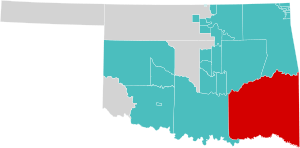
Location (red) in the U.S. state of Oklahoma
|
|||
| Recognized | January 3, 1786 (Treaty) | ||
| Established | September 27, 1830 (Treaty) | ||
| Expansions | 1843–1855 | ||
| Reductions | 1855–1867 | ||
| Constitution | January 11, 1860 | ||
| Annexed by the U.S. | November 16, 1907 | ||
| Self-determination | 1971 | ||
| Reservation Reconstituted | July 9, 2020 | ||
| Capital | Durant (de facto) Tuskahoma (de jure) |
||
| Subdivisions | 12 Districts | ||
| Government | |||
| • Type | Republic | ||
| • Body | Choctaw Nation Council | ||
| Area | |||
| • Total | 28,140 km2 (10,864 sq mi) | ||
| Population
(2020)
|
|||
| • Total | 226,984 | ||
| • Density | 8.0669/km2 (20.8932/sq mi) | ||
| 48,000 Choctaw/Nat. Am. 185,126 White and other |
|||
| Demonym(s) | Choctaw | ||
| Time zone | UTC−06:00 (CST) | ||
| • Summer (DST) | UTC−05:00 (CDT) | ||
| Total population | |
|---|---|
| 223,279 total enrollment, 84,670 enrolled in Oklahoma |
|
| Regions with significant populations | |
| United States (Oklahoma) | |
| Languages | |
| English, Choctaw | |
| Religion | |
| Evangelical Protestantism | |
| Related ethnic groups | |
| other Choctaw bands, Chickasaw |
The Choctaw Nation (in Choctaw: Oklahumma Chahta Okla) is a Native American territory. It covers a large area in southeastern Oklahoma, in the United States. This territory is about 6,952,960 acres (28,138 square kilometers).
The Choctaw Nation is the third-largest federally recognized tribe in the U.S. It is also the second-largest Indian reservation by land area, after the Navajo Nation. As of 2011, the tribe has 223,279 members. About 84,670 of these members live in Oklahoma. The Choctaw Nation's area covers parts of 10.5 counties in Oklahoma. Its main government office is in Durant, Oklahoma.
The Choctaw Nation shares borders with the Chickasaw, Muscogee, and Cherokee reservations. It also borders the U.S. states of Texas and Arkansas. The Choctaw Nation is larger than eight U.S. states, including Hawaii and Massachusetts.
The current chief of the Choctaw Nation is Gary Batton. He became chief on April 29, 2014. The main headquarters for the Choctaw Nation is in Durant. This is where the Chief's office is located. The tribe's court system is also in Durant. The tribal legislature meets in Tuskahoma, at the Council House. The historic Choctaw Capitol Building in Tuskahoma is now a museum.
The Choctaw Nation is one of three federally recognized Choctaw tribes. The others are the Mississippi Band of Choctaw Indians and the Jena Band of Choctaw Indians in Louisiana. These other groups are descendants of Choctaw people who did not move to Indian Territory. The Choctaw Nation of Oklahoma includes those who were forced to move, a journey known as the "Trail of Tears."
In July 2020, the Supreme Court decided that a large part of eastern Oklahoma never stopped being a Native reservation. This area includes lands of the Choctaw, Chickasaw, Cherokee, Muscogee, and Seminole nations. This ruling means the Choctaw Nation is now officially an Indian reservation again.
Contents
- Exploring Choctaw Lands
- How the Choctaw Nation is Governed
- Choctaw Nation's Economy
- Helping U.S. Troops: Freedom Award
- A Look at Choctaw History
- The Treaty of Dancing Rabbit Creek (1830)
- Establishing a Reservation in Oklahoma (1830-1860)
- The Choctaw Mission's Influence (1840)
- Helping During the Great Irish Famine (1847)
- The American Civil War (1861-65)
- Transition to Statehood (1900s)
- Pioneering Code Talking (1918)
- Citizenship Rights (1920s)
- Self-Determination and Growth (1970s-Present)
- Notable Choctaw Tribal Members
- Images for kids
Exploring Choctaw Lands
The Choctaw Nation of Oklahoma's reservation covers about 10,864 square miles (28,138 square kilometers). This area includes eight full counties and parts of five other counties in southeastern Oklahoma.
These counties are:
- Atoka County
- Most of Bryan County
- Choctaw County
- Most of Coal County
- Haskell County
- Half of Hughes County
- A portion of Johnston County
- Latimer County
- Le Flore County
- McCurtain County
- Pittsburg County
- A portion of Pontotoc County
- Pushmataha County
How the Choctaw Nation is Governed
The main offices for the Choctaw Nation are in Durant. A new, large headquarters building opened in June 2018. It is a 5-story building on an 80-acre campus. Other tribal buildings, like health clinics and community centers, are also nearby.
The Choctaw Nation is led by its Chief, Gary Batton, and Assistant Chief, Jack Austin, Jr. The Tribal Council meets every month in Tuskahoma.
The tribe follows the Choctaw Nation Constitution, which was approved in 1984. This constitution sets up three parts of government:
- The executive branch (led by the Chief)
- The legislative branch (the Tribal Council)
- The judicial branch (the courts)
The Chief is elected every four years. The Tribal Council has twelve members, each elected from a different district. They serve four-year terms.
To be a citizen of the Choctaw Nation, a person must be a Choctaw Indian by blood. Their name must appear on the official rolls from 1906, or they must be a direct descendant of someone on those rolls.
The Choctaw Nation's budget for the fiscal year 2017-2018 was over $516 million. This money helps fund many programs and services for the Choctaw people.
Politically, most of the Choctaw Nation is in Oklahoma's 2nd congressional district. The region tends to vote for Republican candidates in U.S. presidential elections. However, the current Chief, Gary Batton, is a Democrat.
The Choctaw Nation has the right to send a non-voting delegate to the U.S. House of Representatives. This right comes from the 1830 Treaty of Dancing Rabbit Creek. As of 2020, no delegate has been sent yet.
Executive Leadership
The Chief of the Choctaw Nation holds the highest executive power. The Assistant Chief is chosen by the Chief and approved by the Tribal Council. The current Chief is Gary Batton, and the Assistant Chief is Jack Austin, Jr.
The Chief's birthday (December 15 for Chief Batton) is a special holiday for the tribe. On October 16, the tribe celebrates Choctaw Flag Day. This day honors the adoption of the Choctaw Nation Seal in 1860.
Past Leaders and Districts
Before Oklahoma became a state in 1907, the Choctaw Nation had three districts: Apukshunnubbee, Moshulatubbee, and Pushmataha. Each district had its own chief for a time. Later, one main chief led the whole tribe. These districts were removed when Oklahoma became a state. The tribe later reorganized its government.
List of Chiefs
| Choctaw Nation, Indian Territory (1834-1906) |
Districts | |||||
|---|---|---|---|---|---|---|
| Moshulatubbee | Apukshunnubbee | Pushmataha | ||||
| District Chief | Term | District Chief | Term | District Chief | Term | |
| Moshulatubbee | 1834-1836 | Thomas LeFlore | 1834-1838 | Nitakechi | 1834-1838 | |
| Joseph Kincaid | 1836-1838 | |||||
| John McKinney | 1838-1842 | James Fletcher | 1838-1842 | Pierre Juzan | 1838-1841 | |
| Nathaniel Folsom | 1842-1846 | Thomas LeFlore | 1842-1850 | Isaac Folsom | 1841-1846 | |
| Peter Folsom | 1846-1850 | Salas Fisher | 1846-1850 | |||
| Cornelius McCurtain | 1850-1854 | George W. Harkins | 1850-1857 | George Folsom | 1850-1854 | |
| David McCoy | 1854-1857 | Nicholas Cochnauer | 1854-1857 | |||
| Districts abolished in 1857 | ||||||
| Unified Nation | ||||||
| Governor | Term | Party | ||||
| Alfred Wade | 1857-1858 | None | ||||
| Tandy Walker | 1858-1859 | None | ||||
| Basil LeFlore | 1859-1860 | None | ||||
| Principal Chief | Term | Party | ||||
| George Hudson | 1860-1862 | National | ||||
| Samuel Garland | 1862-1864 | National | ||||
| Peter Pitchlynn | 1864-1866 | National | ||||
| Allen Wright | 1866-1870 | National | ||||
| William Bryant | 1870-1874 | Union | ||||
| Coleman Cole | 1874-1878 | Union | ||||
| Isaac Levi Garvin | 1878-1880 | National | ||||
| Jackson F. McCurtain | 1880-1884 | Republican | ||||
| Edmund McCurtain | 1884-1886 | Republican | ||||
| Thompson McKinney | 1886-1888 | Union | ||||
| Benjamin Smallwood | 1888-1890 | National | ||||
| Wilson N. Jones | 1890-1894 | Union | ||||
| Jefferson Gardner | 1894-1896 | Union | ||||
| Green McCurtain | 1896-1900 | Republican | ||||
| Gilbert Wesley Dukes | 1900-1902 | Union | ||||
| Green McCurtain | 1902-1906 | Republican | ||||
| Choctaw Nation of Oklahoma (1906–Present) |
||||||
| Chief | Term | Party | ||||
| Green McCurtain | 1906-1910 (Appointed by Roosevelt in 1906) |
Republican | ||||
| Victor Locke, Jr. | 1910-1918 (Appointed by Taft) |
Republican | ||||
| William F. Semple | 1918-1922 (Appointed by Wilson) |
Democratic | ||||
| William H. Harrison | 1922-1929 (Appointed by Harding) |
Republican | ||||
| Ben Dwight | 1929-1937 (Appointed by Hoover) |
Republican | ||||
| William A. Durant | 1937-1948 (Appointed by Roosevelt) |
Democratic | ||||
| Harry J. W. Belvin |
1948-1959 |
Democratic | ||||
| C. David Gardner | 1975-1978 | Democratic | ||||
| Hollis E. Roberts | 1978-1997 | Democratic | ||||
| Gregory E. Pyle | 1997-2014 | Democratic | ||||
| Gary Batton | 2014–Present | Democratic | ||||
Legislative Branch: The Tribal Council
The Tribal Council makes the laws for the Choctaw Nation. Its members are elected by the Choctaw people. There is one council member for each of the twelve districts in the Choctaw Nation.
| Current Tribal Council | ||||
|---|---|---|---|---|
| District | Portrait | Councilman | First elected | Term ends |
| District 1 | Thomas Williston | November 29, 2010 | September 4, 2023 | |
| District 2 | Johnathan Ward | September 7, 2015 | September 4, 2023 | |
| District 3 | Eddie Bohanan | September 2, 2019 | September 4, 2023 | |
| District 4 | Delton Cox | September 3, 2001 | September 5, 2021 | |
| District 5 | Ronald Perry | September 5, 2011 | September 4, 2023 | |
| District 6 | Jennifer Woods | September 4, 2017 | September 5, 2021 | |
| District 7 | Jack Austin | September 3, 2001 | September 5, 2021 | |
| District 8 | Perry Thompson | September 1, 1987 | September 4, 2023 | |
| District 9 | James Dry | September 4, 2017 | September 5, 2021 | |
| District 10 | Anthony Dillard | September 5, 2005 | September 5, 2021 | |
| District 11 | Robert Karr | September 2, 2019 | September 4, 2023 | |
| District 12 | James Frazier | September 3, 1990 | September 5, 2021 | |
Council members represent the Choctaw people in their government. To be elected, a candidate must have lived in their district for at least one year. They must also be at least one-fourth Choctaw by blood and at least 21 years old.
The Tribal Council holds regular meetings. They are in charge of making rules and laws for the Choctaw Nation. They also approve budgets and make decisions about tribal property. The Council helps with economic development and manages tribal resources. This helps the nation become more self-sufficient.
Judicial Branch: The Courts
The Choctaw Nation's court system includes the Court of General Jurisdiction (District Court and Appellate Division) and the Constitutional Court. The Constitutional Court has three members chosen by the Chief. At least one judge, the Chief Justice, must be a lawyer licensed in Oklahoma.
Court Members
- Constitutional Court
- Chief Justice David Burrage
- Judge Mitch Mullin
- Judge Frederick Bobb
- Appellate Division
- Presiding Judge Pat Phelps
- Judge Bob Rabon
- Judge Warren Gotcher
- District Court
- Presiding District Judge Richard Branam
- District Judge Mark Morrison
- District Judge Rebecca Cryer
Treaties with the U.S. Government
The Choctaw Nation has signed many treaties with the United States. These treaties have changed the Choctaw government over time. The Choctaw Nation divides these into "Pre-Removal Treaties" and "Post-Removal Treaties."
Choctaw Nation's Economy
In 2010, the Choctaw Nation's economy had an impact of over $822 million. The tribe employs almost 8,500 people worldwide. About 2,000 of these jobs are in Bryan County, Oklahoma. The Choctaw Nation is the largest employer in Durant. The nation's total payroll is about $260 million each year. Its businesses and government bring in over $1 billion in revenue.
The Choctaw Nation has helped improve the local area. They have built water systems, roads, and other important structures. They have also helped fund fire stations, EMS units, and law enforcement. This support has helped the region grow.
The Choctaw Nation runs many different businesses. They have seven casinos, 14 tribal smoke shops, and 13 truck stops. They also own two Chili's restaurants. Other businesses include a printing operation, a drug testing service, hospice care, and a metal fabrication business. They also have a company that provides staff for military bases and embassies.
Helping U.S. Troops: Freedom Award
The Choctaw Nation of Oklahoma has helped people outside their nation. They supported U.S. troops serving overseas by sending care packages. They sent almost 3,500 packages to troops in Iraq and Afghanistan.
In 2008, the Choctaw Nation received the Secretary of Defense Employer Support Freedom Award. This is the highest award given by the U.S. Government to employers. It recognizes support for employees who serve in the National Guard and Reserve. The Choctaw Nation was one of 15 groups to receive this award in 2008. They were chosen from 2,199 nominations.
The Choctaw Nation was the first Native American tribe to receive this important award. Senator Jay Paul Gumm said, "The Choctaw Nation has gone above and beyond to support those men and women."
A Look at Choctaw History
The Treaty of Dancing Rabbit Creek (1830)
The Choctaw were recognized as a sovereign nation by the United States in 1786. They fought alongside the U.S. in several wars. However, relations changed after Andrew Jackson became president. He pushed for a law called the Indian Removal Bill, which passed in 1830. This law aimed to move Native American tribes from their lands.
On September 15, 1830, U.S. representatives met with Choctaw chiefs at Dancing Rabbit Creek. They explained that the Choctaw would either have to move or become U.S. citizens. The treaty would give away their traditional lands to the U.S.
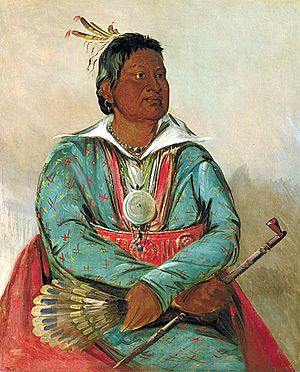
On September 27, 1830, the Treaty of Dancing Rabbit Creek was signed. This was one of the largest land transfers between the U.S. government and Native Americans that did not involve war. The Choctaw were the first tribe to experience the "Trail of Tears," a forced journey from their homes.
A part of the treaty allowed about 1,300 Choctaws to stay in Mississippi and become U.S. citizens. Another part aimed to have a Choctaw representative in the U.S. House of Representatives. At this time, the Choctaw split into two groups: the Choctaw Nation of Oklahoma and the Mississippi Band of Choctaw Indians.
Establishing a Reservation in Oklahoma (1830-1860)
The Indian Removal Act, signed in 1830, led to the creation of Indian Territory. This is where the U.S. government forced many tribes, including the Choctaw, to move. The forced relocation of the Choctaw Nation began in 1831. This journey is known as the Trail of Tears.
In 1834, the U.S. Congress defined the first Indian Territory. The Five Civilized Tribes (including the Choctaw) occupied the land that later became Oklahoma.
The Choctaw Mission's Influence (1840)
Reverend Cyrus Kingsbury, who had worked with the Choctaw since 1818, moved with them to Indian Territory. He started a church in Boggy Depot in 1840. This church building was used as the temporary capital of the Choctaw Nation in 1859. Allen Wright, a future Choctaw chief, spent much of his early life with Kingsbury.
Helping During the Great Irish Famine (1847)
During the Great Irish Famine (1845–1849), the Choctaw people collected $170 to help starving Irish families. This was a remarkable act of kindness. It had been only 16 years since the Choctaw themselves had suffered on the Trail of Tears.
To remember this event, a sculpture called Kindred Spirits was put up in Midleton, Ireland, in 2015. A group of 20 Choctaw Nation members attended the opening.
In 2018, the Irish Prime Minister announced the Choctaw-Ireland Scholarship Programme. This program allows Choctaw students to study in Ireland. It honors the Choctaw Nation's generosity during the famine.
The American Civil War (1861-65)
During the American Civil War, the Choctaws sided with the Southern states (the Confederacy). Many tribal members were successful cotton farmers and owned slaves. Robert McDonald Jones, an influential Choctaw leader, helped guide the Choctaw Nation to ally with the Confederacy.
By 1860, the Choctaw Nation was a peaceful and growing society. Many Choctaw citizens had become successful farmers and business people. Historian Angie Debo wrote that this period showed "orderly development almost unprecedented."
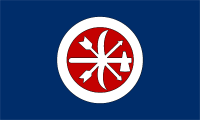
Transition to Statehood (1900s)
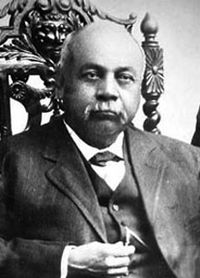
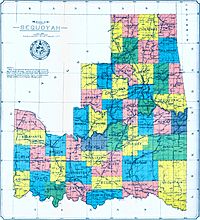
In the early 1900s, the U.S. government passed laws that reduced the Choctaw's power. This was done to prepare for Indian Territory to become part of the new state of Oklahoma.
Under the Dawes Act, the government divided tribal lands into individual plots. Any land left over was sold to others. This act went against earlier treaties. After Oklahoma became a state in 1907, the U.S. Secretary of the Interior appointed the tribal chiefs.
Pioneering Code Talking (1918)
During World War I, the American army in France had trouble with German forces intercepting their messages. The Germans could understand the American codes.
Several Choctaw soldiers in the 142nd Infantry suggested using their native language, the Choctaw language, to send secret messages. The Germans could not understand the Choctaw language. This helped the Americans protect their plans and quickly changed the course of the Meuse-Argonne battle.
Historians say that the Choctaw language did not have words for many military terms. So, the code talkers created new terms. For example, they used "big gun" for artillery and "little gun shoot fast" for machine gun. These soldiers helped end World War I faster.
There were fourteen Choctaw Code Talkers. The U.S. Army later used Native Americans from other tribes, like the Navajo, as code talkers in World War II.
Citizenship Rights (1920s)
The Burke Act of 1906 stated that tribal members would become full U.S. citizens within 25 years. In 1928, Choctaw and Chickasaw leaders met in Ardmore, Oklahoma. They discussed problems caused by new laws, including the Indian Citizenship Act. Their tribal governments had been abolished, making it hard to get funds owed to them.
A committee was formed to address these concerns. For the first time, two women, Czarina Conlan (Choctaw) and Estelle Chisholm Ward (Chickasaw), were sent to Washington, D.C., to represent their tribes. They argued for selling tribal coal and asphalt lands but keeping restrictions on other Indian land sales.
Self-Determination and Growth (1970s-Present)
In the 1970s, the Choctaw Nation worked to regain control of its government and culture. They focused on local solutions to build their identity and sovereignty.
In 1970, President Richard Nixon ended the government's policy of trying to terminate tribes. On August 24, 1970, he signed a bill that stopped the Choctaw Termination Act of 1959.
In 1971, the Choctaw held their first popular election for a chief since 1907. This was a big step towards self-governance. In 1975, David Gardner was elected chief. That same year, the U.S. Congress passed the Indian Self-Determination and Education Assistance Act. This law changed the relationship between tribes and the federal government. It allowed tribes to manage their own funds and services.
During Gardner's time as chief, a tribal newspaper, Hello Choctaw, was started. The Choctaw, along with the Muscogee and Cherokee nations, also successfully sued the government for riverbed rights.
Discussions began about creating a new constitution for the Choctaw people. Efforts were made to increase tribal membership and voter participation. In May 1979, a new constitution for the Choctaw Nation was approved.
By the end of the 1970s, the Choctaw Nation had transformed. They had a new constitution, an elected chief, a newspaper, and a growing economy. This laid the foundation for their future growth and empowerment.
Notable Choctaw Tribal Members


Many talented individuals are members of the Choctaw Nation:
- Lane Adams (b. 1989), a Major League Baseball player.
- Marcus Amerman (b. 1959), a bead, glass, and performance artist.
- Gary Batton (b. 1966), the current Chief of the Choctaw Nation.
- Ada E. Brown (b. 1974), a federal judge.
- Michael Burrage (b. 1950), a former U.S. District Judge.
- Sean Burrage (b. 1968), President of Southeastern Oklahoma State University.
- Steve Burrage (b. 1952), former Oklahoma State Auditor and Inspector.
- Czarina Conlan (1871-1958), a suffragist and the first woman to represent the Choctaw in Washington, D.C.
- Samantha Crain (b. 1986), a singer-songwriter.
- Scott Fetgatter (b. 1968), a member of the Oklahoma House of Representatives.
- Tobias William Frazier, Sr. (1892–1975), a Choctaw code talker.
- Rosella Hightower (1920–2008), a famous ballerina.
- Norma Howard (b. 1958), a visual artist.
- LeAnne Howe (b. 1951), a writer and academic.
- Phil Lucas (1942–2007), a filmmaker.
- Green McCurtain (d. 1910), a Chief of the Choctaw Nation.
- Cal McLish (1925–2010), a Major League Baseball pitcher.
- Devon A. Mihesuah (b. 1957), an author and historian.
- Joseph Oklahombi (1895-1960), a Choctaw code talker.
- Peter Pitchlynn (1806–1881), a Chief of the Choctaw Nation.
- Oral Roberts (1918-2009), an evangelist.
- William Grady Stigler (1891-1952), a U.S. Representative from Oklahoma.
- Bryan Terry (b. 1968), a member of the Tennessee House of Representatives.
- Tim Tingle, a writer and storyteller.
- Wilma Victor (1919–1987), an educator and first lieutenant in the Women's Army Corps.
- Summer Wesley (b. 1981), an attorney, writer, and activist.
- Wallace Willis, a composer of Negro spirituals.
- James Winchester (b. 1989), a National Football League player.
- Allen Wright (1826-1885), a Chief of the Choctaw Nation.
- Muriel Hazel Wright (1889-1975), a teacher, historian, and writer.
Images for kids




